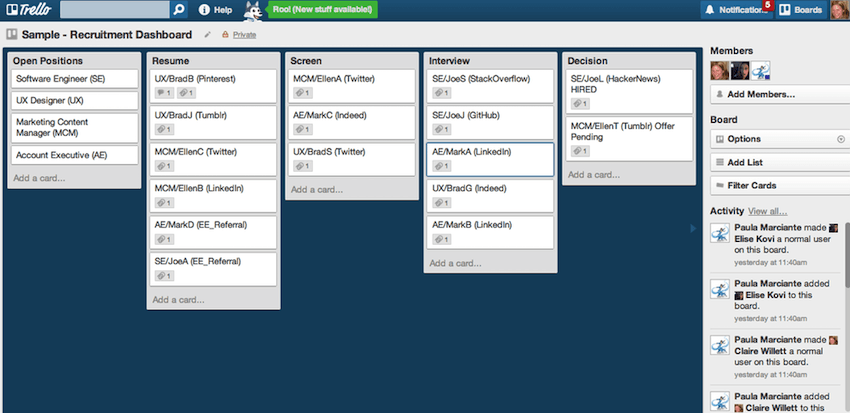A collaborative hiring process for developer roles can be an effective solution – especially for companies whose tech recruiters or HR executives don’t quite have a deep enough technical background to cover all bases. Taking a team-based hiring approach for developers means HR managers collaborating closely with tech managers and developers, leaning on their individual strengths, to assess a potential candidate throughout the recruitment process.
Why is a collaborative approach considered the best way to find yourself an ace developer? What are the steps to HR and tech managers working successfully together in the recruitment process?

3 Reasons Why a Collaborative Hiring Process Rules
1. It leaves the tricky tech talk to the developers
Let’s face it, it’s impressive but almost impossible to be an HR executive, even in the tech field, and know how to navigate your way around the technical side of the many varying developer/engineering roles. With a collaborative approach, you can share the technical portions of the hiring process with members of the engineering team. Remember, your company hired the current engineering team because of their skills and culture fit, so make use of it!
Not only will developers be more fluent in presenting the company’s languages, processes, upcoming projects, etc. but candidates get a chance to connect with the developers that they could, if successful, be working alongside. 48% of developers prioritize working with brilliant colleagues when looking for a new role. A team-based hiring approach could positively impact more than you realize. A candidate will value being able to delve into tech talk, knowing that they are being fully understood and getting their technical questions answered.

A collaborative approach helps tech recruiters spot candidates whose development skills and experience don’t go any further than a well-rehearsed technical spiel. As Stack Overflow’s CEO puts it:
“It’s too easy to fake out one interview […] especially when a non-programmer interviews a programmer.”
Furthermore, in the tech hiring process, the crucial aspect of skills validation should be done collectively by HR and tech managers to get the best results from the process. For example, with coding interview tools, HR managers can easily share their best profiles’ test reports with tech managers so as to decide together on the next assessment steps. This is the perfect example of a collaborative approach, as HR managers alone might struggle to decipher and present the technical test results.
2. It creates the best candidate experience
As William Vanderbloemen at Forbes puts it:
“Throughout the interview process, candidates are evaluating you as much as you are evaluating them.”
This is especially true for tech hiring, where great developers are incredibly sought-after.
By approaching your developer hiring process in a collaborative way – including the current developers at different stages – not only will the job of the HR manager/tech recruiter be made easier, but the candidate will get a far more complete, representative experience of the company and of the team that they’ll be joining. Allowing the candidate to interact with the engineering team (their future teammates) could be a big selling point. You’ll encourage candidates to choose your role over any others they have lined up.
3. It focuses on teams rather than individuals
Let’s start by talking about the problem with traditional hiring. It focuses too much – or solely, even – on the individual. We need to forget about the ‘unicorn’ candidate, Kelly Meissner states:
“Hiring a superstar or two won’t magically make your goals happen.”
Instead, we need to put our focus on the bigger picture; the team, the other technical minds that the developer candidate will be joining.
Shifting focus from the individual from the offset goes hand in hand with a collaborative hiring approach. Putting importance on and assessing the candidate on team dynamics, team collaboration, team effectiveness right from the start is as important, if not more, than assessing individual performance.

The “10x developer” theory – based on a Yale study where the quickest workers outpaced the slower ones by 10 times – supports the importance of a group focus. When these faster programmers worked in teams, they could be up to 2,000 times more productive, not just 10 times. So, rather than just presenting to a developer their new role within the team, how the team works, what frameworks they use etc, let them see it for themselves. Let them into the team during this process by using a collaborative hire approach with your current developers.
3 Steps to HR and Tech Manager Collaborative Recruitment Success
1. Start on the same page
Collaboration between two different teams isn’t always easy. If you start the relationship off well then you’ll have the best chance of a smooth and successful process.
The first thing for an HR manager to do is to discuss with the engineering manager exactly what type of candidate they’re looking for, from skillset to culture fit. The tech manager is best placed to walk you through these points. Use their knowledge of the role to build a candidate profile from the horse’s mouth.

Also, as an HR manager, you’ll need to set realistic expectations of each hiring process’ timescale, even if there’s pressure to find a candidate quickly. Be transparent with the tech manager on interview and testing schedules right from the get-go so that they can easily plan these into their time. Finally, this kick-off meeting allows you to understand the tech manager’s preferences to developer hiring. For example, one engineering manager might like to be kept up to date very regularly. Another manager might prefer occasional video calls.
2. Keep the communication lines wide open
The key to a strong collaboration between HR and tech managers is communication and transparency. This begins right at the start of the process, but should continue through until the new hire joins the company. As an HR manager, your job should be to communicate the full picture to the tech lead – even if the situation looks a little bleak.

Credits: Riparian Data
Make sure to communicate with tech managers at each step of your hiring process. If you don’t use any specific ATS (Applicant Tracking System) internally, a good tip for collaborating around your hiring funnel is to use Trello, the project management tool. Trello allows you to create a dedicated column for each stage of your recruiting process (e.g: Resumes | Pre-screening | First interview | Technical Test | Shortlist).
Share your board with every person involved in the recruitment. Then just drag candidates into the appropriate column as they go through your funnel. It’s visual and everyone will see at a glance how things are going. Also, don’t forget to allow time for feedback within your team. For example, Jeff McConathy, VP of Engineering for Consumer Services at Trulia, always conducts a post-interview meeting to share feedback.
3. Provide first-class candidate experience during technical interviews
From an HR perspective, candidate experience is invaluable for the potential hire. First, a positive candidate experience will help you stand out from the competition, showcasing a strong employer brand. Second, it will ease the relationship between HR and tech managers. Create the best experience possible for candidates. Tech managers will see that you’re doing everything possible to promote the company and its tech-friendly side. During the pre-screening phase, notify candidates of the reception/rejection of their application. For short-listed candidates, send clear invitation emails to interview. The trickiest part remains the technical interview phase which can be particularly stressful for your future hires.

You can smooth out your candidate’s experience during technical tests by providing tech colleagues with everything they need to conduct them – for example; specific meeting rooms with whiteboards and bottles of water, ready-to-use technical equipment and computers, availability (and punctuality) of other team members who want to be involved in the interview – show that you understand and respect the importance of these elements to a successful hiring process.
3 Key Takeaways
3 key points about collaborative hiring in tech:
- Always utilize engineering managers and development team members’ different skills and strengths during the hiring process
- If in doubt, communicate with managers at all times using appropriate tools. No-one is a mind reader, so always share updates throughout the process – best to share to much than not enough!
- Keep the candidate’s experience at the forefront of the process, especially during technical interviews

